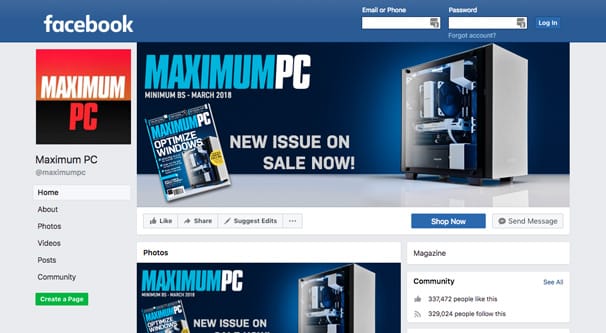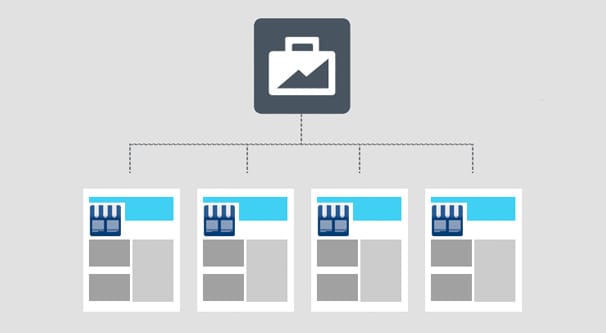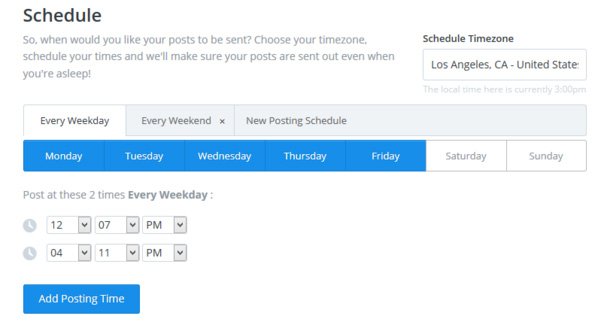 Written by ContentPowered.com
Written by ContentPowered.com
There are a few instances where you might be managing more than one Facebook page at once. If you fall into the category of people assigned to do so, you’ll want to approach it the right way.
Determine if You Need Multiple Pages
The first thing you need to do is determine whether or not you actually need to be managing more than one Facebook page at a time.
Facebook isn’t like Twitter. Twitter allows you to have multiple accounts for different purposes. The way I see it, a good business could have up to three normally; one for their main business feed, one for customer service, and one for a bot that can dispense helpful information. In the case of large franchises, each individual franchise location can have their own Twitter account.
With Facebook, this isn’t necessarily true. For one thing, you don’t want to split customer service off onto its own page. There’s no benefit to doing so, and no value in it, unless I suppose you wanted to build a custom audience out of just the people who have issues with your product or service.
So what possible reasons are there to run more than one page at once? Let’s look at a few possibilities.
First up is if you’re actually a marketing agency managing multiple client pages for them. Agencies often manage dozens or even hundreds of pages at a time, and they do so in a variety of different ways. They might use third party dashboards like Hootsuite to do the heavy lifting. They might use the Facebook Business Manager with their account set as a sub-admin on their client pages. They might just do it tediously and manually, though any company doing so probably isn’t long for the world.
Secondly is if you bought or acquired another business, or merged with another one, and want to keep both pages active. One semi-high profile version of this is the merger between PC Gamer and Maximum PC. The two magazines maintain their own print editions, but they merged their websites, and now their Facebook pages are controlled by the same people.
Third is if you’re part of a franchise; each location in a franchise can have their own page to take advantage of local search. Many large franchises, particularly fast food places, generally don’t do this. Mid-sized franchises, where individuality between locations can be a benefit rather than a brand drawback, will be more likely to create and run individual pages.
Other than these three, I can’t think of many reasons you might want to have more than one page. You can’t really grow a second page with the intention of merging it into your first with any success, since the pages need to be similar to be merged and so your audience would have a lot of overlap. Having separate pages for different business functions doesn’t do anyone any good, and bots can be integrated with your page chat without needing a page of their own.
Determine Unique Needs
If you’re managing more than one Facebook page, you need to determine how unique each of those pages needs to be. I place things into three broad categories.
Category 1: mostly similar. The Maximum PC/PC Gamer setup falls into this category. PC Gamer is the much larger, more active page. Virtually everything the Maximum PC page shares is also posted on PC Gamer. Essentially, Maximum PC is a smaller page aimed at people who have interests in computer hardware and tech, but who don’t want to be inundated with gaming news and announcements throughout the day.
This is generally not a viable option, to be honest. It works for the PC duo because they came from initial, divided audiences and they wouldn’t take kindly to merging. It also works because both magazines still exist independently in print; they don’t cover all the same material or cross-post stories. It’s a fairly unique situation.
Category 2: franchises. This is the ideal for individual franchises of a larger brand. Essentially, you will want to mandate certain specifics about the pages, but leave the rest up to the individual teams at each franchise.
What do you mandate? Make sure the pages have a consistent naming scheme, consistent branding and imagery, and probably some consistent “you have to post this” links that are important to the brand as a whole. Everything else can be left up to the individual franchise owners or managers who are in charge of running that local page.
This does require that you trust the individual franchise owners to successfully manage a Facebook page, so sometimes it might be more valuable to take control of the whole thing for yourself.
Category 3: complete differentiation. This is the agency method, where you may be managing multiple Facebook pages at the same time, but all of them are unique and individual. You wouldn’t run the pages for a shoe store, a game shop, and a sports center in the same way, would you? You need individual content, individual techniques, individual paid advertising, and all the rest.
In most cases, you’re going to end up in the third category. The first is fairly rare and it’s often better to simply merge the pages. You can read more about merging pages here.
Use a Third Party Tool
Now let’s get down to some actual business tools. You generally want to use tools to manage more than one Facebook page at once, because it can get very easy to confuse which page you’re on and which content is supposed to go where. Ideally, you’ll have individual teams for each individual page you want to manage. However, I know that a lot of businesses don’t have the kind of employee numbers or budget to do so. Instead, you want some kind of system to keep everything straight.
The first option you have available to you comes right from Facebook, making it not strictly a third party tool. However, since it’s not a default part of using Facebook pages, I’m listing it as if it were.
This tool is the Facebook Business Manager. The Facebook Business Manager has a few perks to it. For one thing, it allows you to add multiple Facebook pages to your business manager, so you can manage them all in one place, without having to tediously swap between them or log in and out repeatedly. It has special permissions for people assigned to manage different pages, and you don’t need to be a page owner to be added to manage a page.
Facebook considers business manager to be ideal for everyone managing more than one page, and even for people who manage a single page with a team of users. As they say, use business manager if you have a marketing team, if you’re managing multiple pages, if you’re working with a vendor, if you’re managing assets like ad accounts or apps, if you need access and permissions control, or if you want broad-spectrum management for your page.
Business manager has one primary benefit, which is that as a Facebook offering, it’s free and fully-featured. You don’t have to allocate a marketing budget to buying your platform, you can just use what Facebook provides. On the other hand, it only provides a few advanced features, and leaves out a lot of what is considered broadly useful to most businesses running a Facebook page. Most notably, it doesn’t handle interactions with other systems, except possibly setting something up through IFTTT or Zapier.
Hootsuite is one I already mentioned up above. They’re one of the largest and most fully-featured social media managers on the web, and they work for just about everyone.
The free version of Hootsuite works with up to three social profiles but has no team membership and a limit of 30 scheduled messages. The professional plan is $20 per month and allows up to 10 social media profiles, unlimited scheduling, bulk scheduling, analytics, and RSS integration. RSS can be excellent if you’re running different pages for different websites; you can get their blog feeds directly as posts with a relative minimum of effort.
For $99 per month you get up to 20 profiles and a small team of three users, so you don’t have to mess around with sharing the Hootsuite password with your team. You also get some templates, a branded URL, and some other stuff if you want it. If you need more team members, training, and premium app access, Hootsuite has a $499 per month plan as well.
Sprout Social is another option you can investigate; they aren’t as robust and as granular as Hootsuite, but they have a lot of higher end features. There are, of course, other options as well.
Tips for Growth
When it comes down to actually growing your Facebook pages, it’s really no different than just growing one; it just takes more work.
First of all, you need to make sure to spend an equal amount of time with each of them. At least, you need to spend an amount of time with each of them commensurate with the amount of money the owner is paying you as an agency. A small page with a small budget likely won’t get as much attention as a much larger page on a more expensive plan. Regardless, you need at least a baseline amount of effort.
Keep every page you manage active and up to date. You generally want to post at least once each day, possibly more if you have a large audience or you represent a very fast-moving industry. If you’re managing more than two or three Facebook pages at a time, that can mean producing a lot of content. It can be worthwhile to have a checklist of items you need to cover for each page in a given week or month, to make sure you don’t forget anything.
Feel free to schedule, even bulk schedule if the option is available to you with whatever system or app you’re using. Bulk scheduling simply involves creating a spreadsheet with cells for the date and time, and cells for the post that will go up, possibly with the URL of an image to upload as well. You can create all of this content without needing to work through the app or Facebook directly, to save time and effort.
You may also want to create a media library. A library for each page can contain images you can use for posts, links to evergreen content that can be posted any time you need filler, and even basic ads to run if you’re finding a budget surplus at the end of a season.
Always double-check what you’re doing before you submit. The last thing you want to do is spend the ad budget of one company on ads for another, post organic content on the wrong page, or respond to comments while posting as the wrong page. These kinds of mix-ups are rare, but when they happen, they can make clients quite irate.
Don’t try to do everything for every page every day. For example, with every Facebook page, you want to be checking page and post analytics to refine your future strategies. You should not, however, make “analytics day” and pull the analytics for every page on the same day. It’s easy to get data mixed up if you do so, then you might make changes based on data for the wrong page. Do one page every few days, or one each week, on a rotating basis.
If you’re an agency working with varied clients, make sure to remember each of them have their own goals and ideas of what is most valuable. Different businesses might have different performance indicators they want measured, so you need to approach different pages in different ways.
In general, however, growing a Facebook page is the same regardless of how many you’re doing at once. It just takes more time, more money, and more investment.






Hi Eric Great article with lots of information. I would like to confirm something please. I am running several different events around the country where guests pay to attend. I would like to have a face book page per event where I could upload event specific content such as videos, podcasts and reports etc. Is this possible and allowed? Thanks Rich